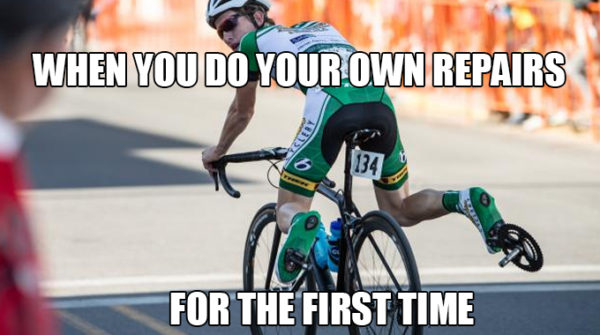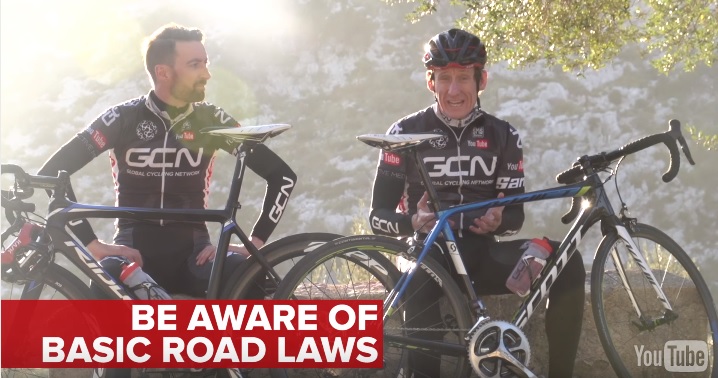We all make mistakes, but when it comes to our bikes they can be costly. Here are some of the most common mistakes to avoid while fixing your bike.

1: Tube and Tire Mistakes
One common issue always comes up when fixing a bike becomes necessary. It happens when you fail to seat the bead, and attempt to air up the tire. The tube bulges out between the tire and rim and then BANG! There goes a new tube. Always check around the perimeter of the tire to make sure it’s inside the rim. You will also want to make sure that you can’t see the inner tube when you push the tire inward so you can see the inside of the rim. A tube between the tire and rim will flat instantly as well. Keep checking all the way around also as you add pressure so it doesn’t slip out.
Many a new tube has been pinch-punctured by using tire levers to g
et the tire back on, leading to any amount of frustration, bad words, and a tire that won’t hold air. It happens when you mistakenly get the under-inflated tube between the rim and tire lever. When you use the lever to pry, it pinches a hole, and you never know it till you try to inflate the tube. It’s best to skip the levers and use your thumbs and finger to apply brute force to get the tire back on the rim. Sometimes though the tire is simply too tight and you need to use levers; just be careful.
2: Bad PSI
Failure to air up the tire to it’s proper PSI (Pounds per Square Inch) promotes premature tire wear, poor handling and performance. Too much air is dangerous. Always check the side of the tire for the printed info and get the PSI right. If you’re heavier, error with a few more pounds, if you’re lighter, you can take a few out to soften your ride.
3: Not Understanding Tools When Fixing A Bike
A multi-tool might sound like it can repair anything that can go wrong when fixing a bike, and most of them do. But if it doesn’t have the right bits or tips to adjust your saddle height, shift your slipped handlebar, adjust your headset, or fix a broken chain, then it’s a waste of space and added weight. Get to know what your multi-tool is capable of. The chain breaker is probably one of the tools that you should practice with ahead of time. They can be difficult to use if you don’t know what you’re doing especially on the side of the road.
4: Failing to Change a Cable
A fraying cable is ugly. There’s nothing worse than to look down and see a frayed cable hanging from the derailleur or emerging from your shifter or brake lever. Once cables start to fray there’s no going back, replace it as soon as possible. Don’t make the mistake of trying to run it any longer than you need to.
Make sure that the cable end caps — they look like silver bullets — are installed at the ends of cables. You can pick them up for pennies at any bike shop. There’s no excuse for running cables without them. When pinching the caps on the end of the cables, make sure you don’t pinch them too hard causing them to split or cut.
5: Messing with Your High and Low Limit Screws
The limit screws in your derailleurs rarely, if ever get loose. They are there to set the limits of your derailleur’s movement up and down. If your bike shifts clean and crisp when you first bought it, chances are you’ll never need to touch the limit screws ever again. Don’t make the mistake of messing with it unless you know what you’re doing. Once you get it out of whack, it can be a pain to get it back where it belongs.
If your shifting has suddenly gone awry, it’s typically NOT because the limit screws are off. It’s because of a dirty cable, cable housing or cable tension or a bent derailleur hanger. Never use a screwdriver on limit screws before trying everything else. Normally it’s just a simple adjustment of the barrel adjuster.
6: Bad Lubing Techniques
This one is one of the most common first time cycling maintenance mistakes; using the wrong lube on your chain (lube that’s not bicycle-specific) and lubing without cleaning first. Adding lube to a dirty chain is a recipe for chain wear and eventual failure. It’s smart to wipe down your chain with a clean rag after every ride. You probably won’t do this, but it’s still a good idea. Then apply the correct lube and give it a light wipe down after to wipe off any excess.
7: Tightening the Quick Release Wrong
The cam (up and down) action of a quick-release is the only way to secure your wheel to the hub. It prevents the wheel from getting wrenched out of the fork when put under sudden, extreme loads. Adjust the skewer nut to allow the lever and cam to swing past top dead center and firmly into the closed position with adequate pressure. The lever is tight when it leaves a small indention in the skin on your palm. Don’t rotate the nut or lever to tighten after it’s closed.
8: Over-Tightening Headset Cap
Modern headset systems are threadless. They work by pre-loading the bearings with the cap on top ( the vertical bolt on top of your steerer-tube is not used to hold the stem in place). The torque to secure the stem is added with pinch bolts perpendicular to the stem.
If you can hear a clunking coming from your front end or if your handlebars feel unstable — then it’s fine to add some pressure to the stem by tightening the cap on top a bit at a time with the bolts on the side loose until the clunking stops. Then tighten down the pinch bolts on the side of the stem. You only need this top bolt tight enough to remove bearing play. If it causes resistance in your steering — it’s too tight. A full run-down is explained here.
9: Failure to do Maintenance on Your Seatpost
Don’t leave your seatpost in the bike for extended periods of time. Three months is doable. Six months is way too long. Seatposts tend to seize up and it makes it impossible to change saddle height. Forcing it up or down results in breaking it. Even if it’s been greased, the grease breaks down and eventually allows oxidation to occur, and moisture seeps into the frame. Not only do metal seatposts seize, carbon posts seize as well. Apply a generous dollop of grease to metal after cleaning. Use carbon specific grease or lube for carbon.
10: Not Closing the Quick Release on Your Brakes
The most common mistake when fixing a bike is saved for last; failure to close the quick release on the brake after changing or removing a tire. All cyclists are guilty of it. The brake quick release allows you to easily remove or install a wheel as the brake opens up further to allow the pumped up tire to easily fit through the brake. If you forget to close the quick release after, you are going to have to pull your brake lever a lot farther for the pads to touch the rim. If they’re too far, they may not have the ability to stop you because your brake levers will bottom out against your handlebars.
